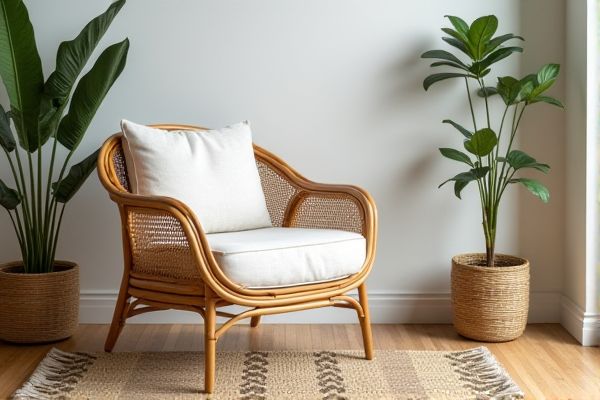
Cane chairs offer a lightweight, breathable seating option with a classic lattice design, while rattan chairs provide a more robust and flexible frame, often woven into intricate patterns for enhanced durability. Discover how these differences impact comfort, style, and maintenance to choose the perfect chair for your space by reading the full article.
Table of Comparison
| Feature | Cane Chair | Rattan Chair |
|---|---|---|
| Material | Derived from cane plant stalks, thin and flexible | Made from rattan vine, sturdy and dense |
| Durability | Moderate, prone to fraying and cracking over time | High durability, resistant to wear and tear |
| Weight | Lightweight, easy to move | Heavier compared to cane |
| Flexibility | Flexible, suitable for intricate weaving | Less flexible, used for solid frame construction |
| Style | Classic, vintage aesthetic | Modern, rustic, or tropical look |
| Maintenance | Requires regular cleaning and careful handling | Easy to maintain, typically weather-resistant |
| Indoor/Outdoor Use | Primarily indoor | Both indoor and outdoor suitable |
| Cost | Generally less expensive | Typically higher price point |
Introduction to Cane and Rattan Chairs
Cane chairs feature seats and backs woven from thin strips of rattan peeled from the outer bark, offering a lightweight and flexible design. Rattan chairs are crafted from the solid core of the rattan vine, providing durability and a natural wood-like appearance. Both materials originate from tropical palm species but differ in texture, strength, and weaving techniques, influencing their style and longevity in furniture design.
What is a Cane Chair?
A cane chair features a frame typically made from wood, with its seat and backrest woven from thin strips of rattan cane, known for durability and breathable comfort. The natural cane material creates a lightweight structure that enhances ventilation, making it ideal for warm climates. Its classic craftsmanship combines traditional weaving techniques with modern design, offering both aesthetic appeal and functional seating.
What is a Rattan Chair?
A rattan chair is crafted from the flexible stems of the rattan palm, known for its lightweight durability and natural, woven texture that adds an organic aesthetic to any space. Unlike cane chairs, which specifically use the outer bark of rattan or other plants, rattan chairs often incorporate the entire rattan vine, offering a sturdier frame and varied weaving patterns. These chairs are valued for their strength, resilience to humidity, and versatility in indoor and outdoor furniture designs.
Material Differences: Cane vs Rattan
Cane chairs are made from the outer bark of the rattan vine, which is peeled into thin, flexible strips ideal for weaving intricate patterns, offering a lightweight yet sturdy structure. Rattan chairs utilize the entire rattan palm, including the solid core, providing greater durability and a more robust frame suitable for heavy use. The material difference results in cane chairs having a more delicate, airy appearance while rattan chairs deliver enhanced strength and a smoother, polished finish.
Durability and Strength Comparison
Cane chairs are made from the outer bark of the rattan vine, making them less dense and generally more fragile compared to solid rattan chairs, which use the entire rattan stalk for greater durability and strength. Rattan chairs offer enhanced sturdiness and resistance to wear, making them ideal for frequent use and heavier support. Your choice between cane and rattan should consider the intended use and desired longevity, as rattan typically provides a more robust seating option.
Design Styles and Aesthetic Appeal
Cane chairs feature a classic woven pattern that adds a light, airy texture ideal for traditional and vintage-inspired interiors, enhancing elegance with their intricate craftsmanship. Rattan chairs showcase a more robust and rustic aesthetic with thicker, naturally curved fibers, perfectly complementing bohemian, coastal, or tropical design styles through their organic warmth. Both materials offer versatile visual appeal but cater to different atmospheres: cane emphasizes delicate refinement, while rattan promotes a casual, natural vibe.
Comfort and Ergonomics
Cane chairs offer firm support with a breathable weave that promotes airflow, making them comfortable for extended seating. Rattan chairs feature flexible fibers woven tightly, providing a slightly cushioned feel that contours to your body, enhancing ergonomic support. Choosing between the two depends on your preference for firmness versus slight flexibility in comfort and posture support.
Indoor vs Outdoor Usage
Cane chairs, crafted from natural cane fibers, are best suited for indoor use as they are more vulnerable to weather damage and moisture, which can weaken the material over time. Rattan chairs, made from durable rattan palm stems, offer greater resilience and flexibility, making them ideal for both indoor and outdoor settings, especially when treated with weather-resistant finishes. Your choice between cane and rattan chairs should consider exposure to elements, with rattan providing enhanced longevity and comfort in outdoor environments.
Maintenance and Care Tips
Cane chairs require regular dusting and occasional wiping with a damp cloth to prevent the natural fibers from drying out and becoming brittle, while rattan chairs benefit from gentle cleaning with a mild soap solution to maintain their glossy finish. Both materials thrive when kept away from direct sunlight and excessive moisture, which can cause warping or mold growth. To extend the lifespan of your chair, apply a light coat of furniture oil to cane and use a protective varnish on rattan surfaces.
Which Chair Should You Choose?
Cane chairs offer a lightweight design with a smooth, glossy finish, making them ideal for indoor use where elegance and breathability are priorities. Rattan chairs are more durable and flexible, suited for both indoor and outdoor settings due to their thicker, woven material that withstands weather elements better. Your choice depends on whether you prioritize aesthetic finesse and light usage with a cane chair or require robust functionality and outdoor resilience with a rattan chair.
 homyna.com
homyna.com